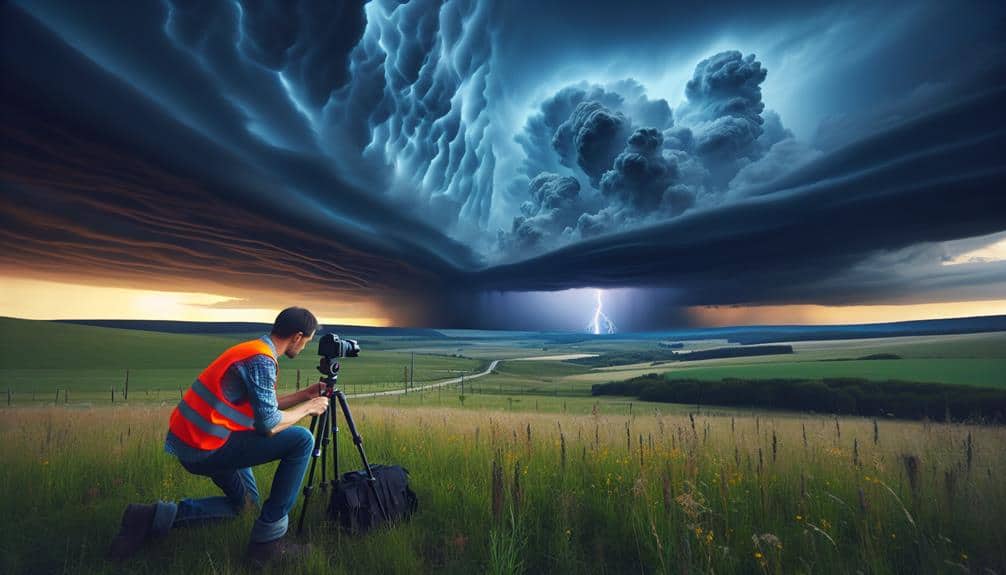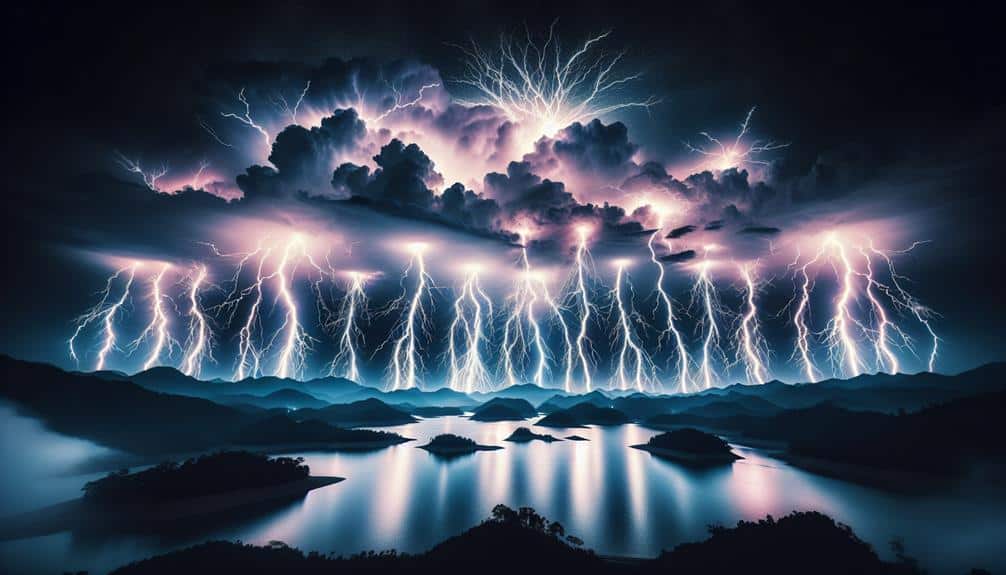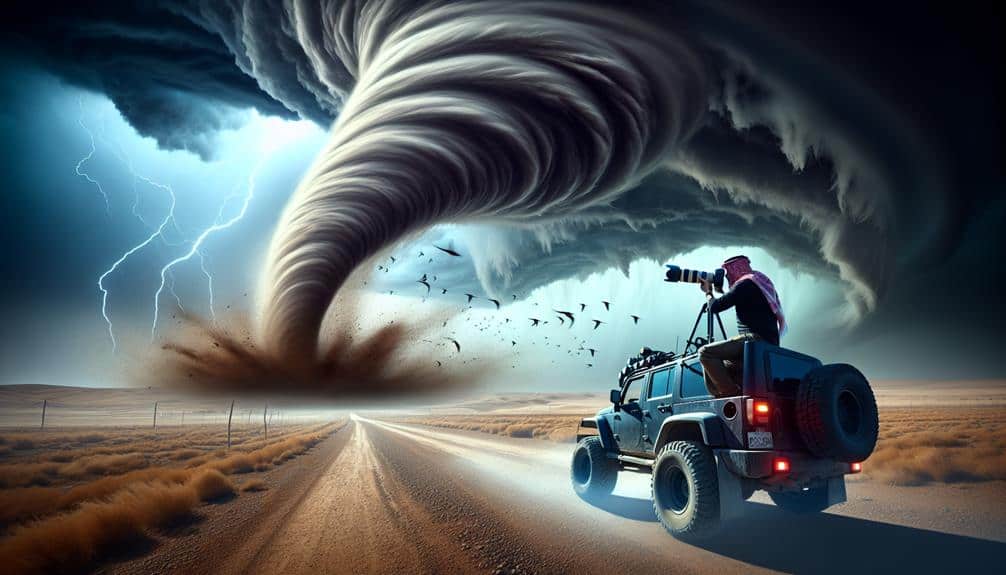Capturing the tranquility before a storm demands meticulous planning and the right tools. We prioritize gear like weather radios, GPS devices, and high-resolution cameras, ensuring everything's maintained and ready. Analyzing weather patterns with real-time data lets us time our shots perfectly. By studying topographical maps and meteorological data, we find the best locations with clear, unobstructed views. Understanding light and shadows at different storm stages helps us capture the subtle changes. Safety comes first, so we always have a risk assessment and emergency plans in place. Dive deeper into our methods to perfect your storm documentation.
Key Points
- Utilize high-resolution cameras to capture the serene landscapes before the storm arrives.
- Analyze weather patterns and real-time data to predict the ideal timing for pre-storm photography.
- Scout elevated and unobstructed locations using topographical maps for capturing calm before the storm.
- Employ sturdy tripods and reliable power sources to ensure stable and uninterrupted pre-storm shots.
Choosing the Right Gear
Choosing the correct gear is necessary for storm chasers to guarantee both safety and the ability to capture high-quality data. We must prioritize gear maintenance to make sure our equipment functions at its best when we need it most.
Vital items include a robust weather radio, GPS device, and high-resolution camera. Regular checks and calibrations are crucial; a malfunctioning piece of equipment can compromise our mission and safety.
Balancing quality gear with budget options is important. While top-of-the-line equipment often offers superior durability and accuracy, there are budget-friendly alternatives that provide comparable performance. For instance, mid-range cameras can deliver excellent image quality without breaking the bank. Similarly, portable weather stations with necessary sensors can be found at reasonable prices, allowing us to gather critical atmospheric data without overspending.
Investing in high-quality gear where it matters most—such as sturdy tripods and reliable power sources—ensures we don't face unexpected failures in the field. We should also prioritize waterproof and shockproof materials, given the harsh conditions we often encounter.
Timing the Perfect Shot
Capturing the perfect shot requires precise timing, as even a few seconds can mean the difference between an ordinary photograph and a breathtaking, scientifically valuable image. To achieve this, we must rigorously analyze weather patterns. By understanding the intricacies of atmospheric conditions, we can predict when the storm will shift from calm to turbulent, allowing us to time our shots perfectly.
We rely on real-time data from weather satellites and Doppler radar to monitor storm development. These tools provide critical insights into pressure changes, humidity levels, and wind speeds, helping us determine the best moment for photography. For instance, a rapid drop in atmospheric pressure often signifies an impending storm, giving us a narrow window to capture the serene moments before chaos ensues.
Equally important is our understanding of storm composition. Identifying the leading edge of a storm front or the formation of a supercell can guide us in positioning our equipment and timing our shots. By synchronizing our photographic efforts with these natural indicators, we maximize the likelihood of capturing images that aren't only visually stunning but also rich in scientific data.
Thus, mastering the timing of our shots involves a blend of scientific knowledge, technological tools, and keen observational skills.
Finding Ideal Locations
Locating the ideal vantage points for storm photography requires a thorough understanding of geography, weather patterns, and accessibility. We start by analyzing topographical maps to identify elevated positions and expansive landscapes, as these offer unobstructed views. By combining meteorological data with these geographical insights, we can predict storm paths and select prime scouting spots.
Remote access is essential. Many of the best locations are far from urban centers, where light pollution and buildings can block our view. We utilize 4×4 vehicles equipped with GPS to reach these isolated areas. Satellite imagery and historical weather data guide us in pinpointing regions with a high frequency of storm activity. Knowing which areas are prone to specific weather phenomena—such as supercell thunderstorms or tornadoes—enhances our chances of capturing striking shots.
Additionally, we consider seasonal variations. For instance, Tornado Alley in the central United States is most active during spring. Our planning includes evaluating road conditions, potential hazards, and emergency evacuation routes to ensure safety.
Essentially, our thorough approach to scouting spots and securing remote access maximizes our ability to document the tranquil moments before nature reveals its power.
Capturing Light and Shadows
Understanding the interplay of light and shadows in storm photography hinges on mastering the nuances of natural illumination and its transformation during different stages of a storm. We need to pay close attention to how light interacts with natural landscapes, creating a visual interplay that can either enhance or obscure our images.
Early in the storm's lifecycle, diffuse light can soften the scene, producing gentle shadows that highlight the contours of the terrain.
As the storm advances, dramatic skies become our canvas. When clouds gather and the atmosphere thickens, light becomes more directional, casting longer and more defined shadows. These shadows can add depth and dimension to our photographs, making the natural landscapes appear even more dynamic. This is the perfect moment to capture the contrast between the illuminated areas and the darkening clouds.
Using data from light meters and histograms, we can precisely measure the exposure and guarantee that our images maintain a balanced contrast. We should also consider the angle of the sun, as it affects shadow length and direction.
Safety Tips for Photographers

Prioritizing safety is pivotal for photographers who venture into volatile weather conditions to capture the majesty of storms. Our freedom to explore and document these natural phenomena hinges on rigorous emergency preparedness and understanding the inherent risks.
1. Conduct Thorough Risk Assessment:
Before heading out, we need to understand the specific weather conditions we'll face. Reviewing meteorological data and forecasts allows us to gauge the storm's severity and potential hazards. Additionally, checking local advisories ensures that we're not heading into unnecessarily risky situations.
2. Effective Location Scouting:
Scouting out locations in advance is essential. Identifying safe vantage points, potential shelters, and exit routes can make the difference between an exhilarating experience and a perilous one. We should always make sure that our chosen spots aren't prone to flooding, lightning strikes, or high winds.
3. Emergency Preparedness:
Equip yourself with the necessary gear: a first aid kit, extra batteries, and a reliable communication device. In the event that things go south, having a pre-determined emergency plan is crucial. Share your itinerary and check-in times with someone who can raise the alarm if you don't return as scheduled.
Frequently Asked Questions
What Motivates Storm Chasers to Document the Calm Before a Storm?
We chase storms to capture nature's power, feeling an adrenaline rush as we document the beauty and danger. This data-driven analysis of calm before chaos helps us understand atmospheric dynamics, granting us the freedom to predict and prepare.
How Do Storm Chasers Prepare Mentally for Their Expeditions?
We prepare mentally for our expeditions through meditation and visualization, incorporating mental exercises and relaxation techniques. These practices enhance our focus and calm, ensuring we're ready to embrace the freedom and unpredictability of the storm-chasing experience.
What Role Does Technology Play in Storm Chasing?
Like modern Argonauts, we harness technological advancements for real-time tracking, drones, and data collection. These tools give us the freedom to navigate treacherous weather, ensuring accurate analysis and safety in the heart of the storm.
How Do Storm Chasers Balance Their Passion With Personal Safety?
We balance our passion with personal safety by integrating risk management and safety precautions. While thrill-seeking and the adrenaline rush drive us, data-driven analysis guarantees we minimize risks and maximize our freedom to chase responsibly.
Are Storm Chasers Usually Part of a Team or Do They Work Alone?
We often balance team dynamics and solo missions. While collaboration enhances safety and data collection, some prefer independence for flexibility and personal freedom. Data shows teams are more common, but solo missions are not uncommon.


